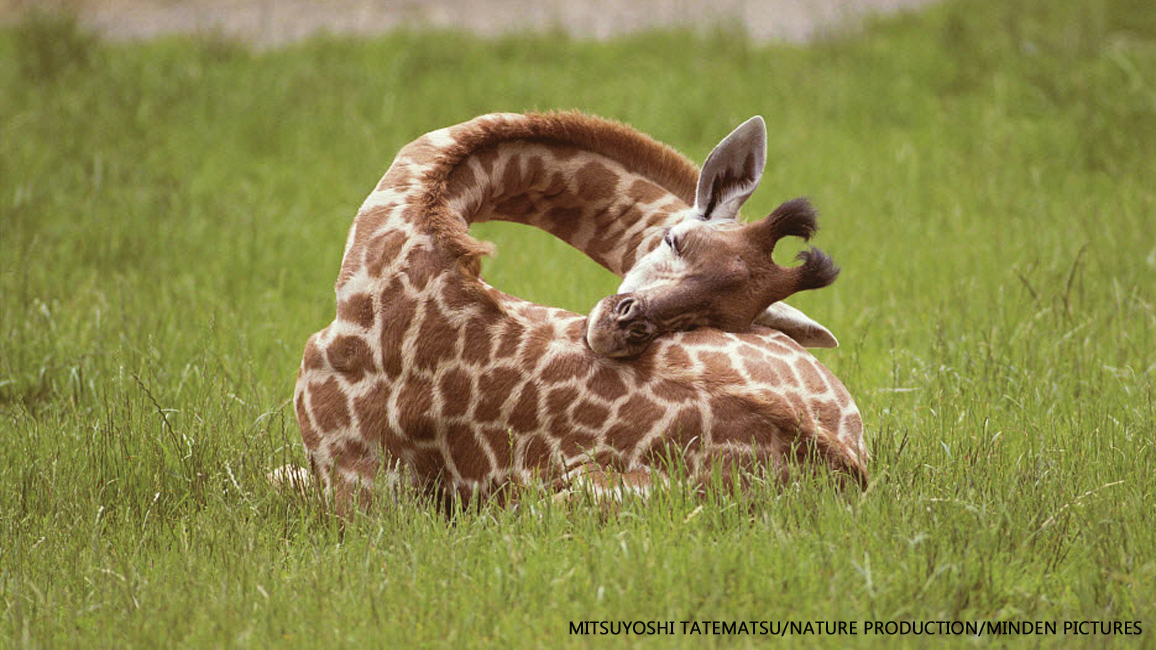
When Animals Snoozzzzzzze
By Gerry BishopSome wild creatures have mighty weird sleeping habits!

If you’re 10 years old, you’ve already spent three or four years of your life zonked out. That’s because we humans snooze for about eight or nine hours each night. All the while, our brains are getting a “tune-up” so we’ll be good to go the next day. Some animals need even more sleep, and others, a lot less. Many animals also sleep in very different ways from how we sleep. Read on to find out how, when, and where some animals catch the zzz’s they need.
Anywhere Bear
This black bear is napping way up in a tree. But just as of ten, bears sleep on the ground—sometimes in dens and other hidden places and sometimes right out in the open.
A Leg Up
You are looking at a sleeping flamingo with one leg up and its head resting on its back. Why sleep standing on one leg? Nobody knows for sure. Scientists suspect this pose may help some birds save energy or keep their bodies warm. Or maybe it’s just more comfortable!
Headfirst
This school bus-sized sperm whale isn’t shooting up to the ocean’s surface for a breath of air. It’s bobbing just below the surface, sound asleep in a nose-up position. After about 15 minutes, the whale will move up to take a breath and then sink back down. Sperm whales sleep for only about two hours a day.

Slumber Party
African wild dogs stick together. This pack is all snuggled up after an exhausting morning hunt. The dogs will sleep the rest of the day and then go off to hunt again in the evening.
All Wrapped Up
This sea otter has drifted off to sleep, but it will not drift away. It has wrapped itself in kelp—a kind of tall seaweed that ’s “anchored” to the bottom of the sea. Ocean currents may come and go, but the sleeping otter is snug in its wet, weedy bed.
Personal Pillow
A giraffe has such a long neck that it can rest it s head on its hip! And that’s where the head will stay while the giraffe takes a quick nap. Mostly, giraffes sleep standing up—just as horses and cows usually do. That way, it’s easier to make a quick getaway when danger threatens.
You Awake?
Closed eyelids are a good clue that an animal is asleep. But like other snakes, this tree python doesn’t have any eyelids to close. So it ’s hard to tell if a snake is asleep or awake. Scientists think snakes do sleep, but they don’t know when, for how long, or whether their sleep is anything like ours.
Jaw-some Zzz’s
This little mason bee has clamped it s jaws on a flower and is sound asleep. Or is it? Like snakes, insects can’t close their eyes, so we have to find other ways to tell. One way is to watch to see if the insect is completely still. Another is to touch it. If it doesn’t stir, you can be pretty sure that bug is snoozing!

Sleeping Sharks?
Whitetip reef sharks are often called “sleeping sharks.” That’s because they gather in underwater caves and look as if they’re sleeping together. But are they really? Divers who swim past say the sharks follow them with their eyes.
Snuggle Buddies
Two snow monkeys snuggle up to keep warm on a snowy day. After a nap, they’ll go off to find food and then take another nap . . . or two. . . or three. At night, they’ll sleep together on the ground, up in a tree, or on a rocky ledge high on a cliff. They’ll snooze away for about 10 hours, not lying down, but sitting up.
Long Winter’s Nap
Bears do it, bats do it, and even this dormouse is doing it. What they do is hibernate (HYE-bur-nate), or go into a deep, deep slumber that lasts for most of the winter.
To survive for so long, the dormouse collected some nuts in the fall to store in its nest. Later, it will wake up, have a snack, and go right back to sleep.
Sacked Out
Every night, this parrotfish finds a hidden spot on a coral reef and settles in. Then, from glands in its mouth, it pumps out a covering of gooey stuff called mucus (MYOO-kuss).
This “sleeping bag” keeps out tiny worm-like creatures that love to attach to fish skin and suck blood. Sleep tight, parrotfish, and don’t let those bloodsuckers bite!
Dozing on Ice
Who would want to sleep on ice? A baby harp seal doesn’t mind. Super-thick fur keeps the seal warm even in the bitterest cold.
There’s still a lot to learn about sleep. But one thing’s for sure: A good snooze is good news for any sleepy creature.
















